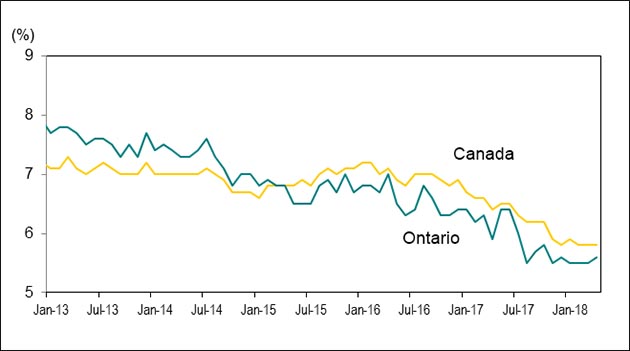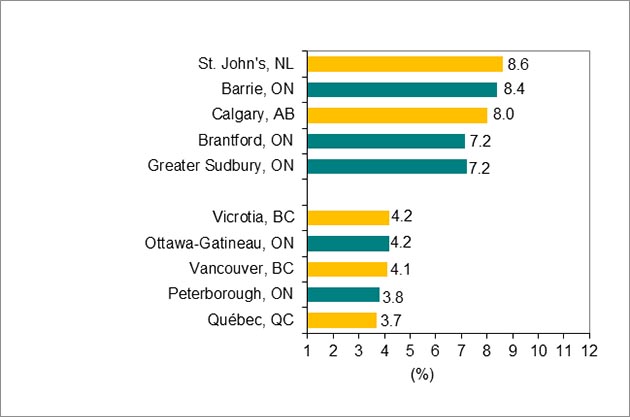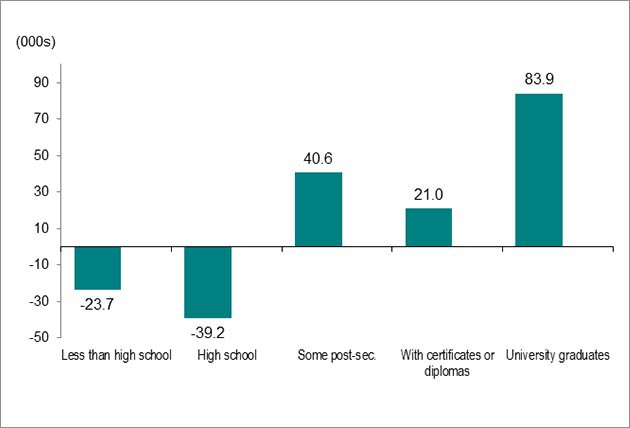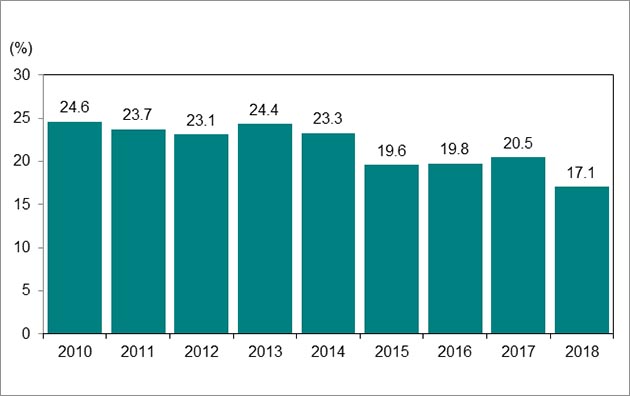Labour market report, April 2018
Employment in Ontario increased in April. Get the details in this report.
Quick facts
In April 2018:
- there were 11.9 million people in Ontario aged 15 years or older
- 7.6 million (64%) were either working or actively looking for work
- 7.2 million (61%) were employed and 82% of them had a full time job
- Ontario’s unemployment rate was 5.6% (424,100 unemployed people)
Employment increased in April
Employment in Ontario increased by 9,300 net jobs in April, following an increase of 10,600 net jobs in March.
Chart 1 shows employment in Ontario from January 2013 to April 2018.

Source: Statistics Canada, Labour Force Survey, Table 282-0087, (seasonally adjusted data).
Full-time vs. part-time
There was a gain in full-time jobs (19,500) in April. Part-time jobs declined by 10,300.
Employment increase/decrease by age
Youth employment (those aged 15 to 24) declined by 22,200 in April, after increasing by 29,900 in March.
People aged 25 to 54 increased in employment by 28,900 in April, compared to March, and those aged 55 and older gained 2,600 jobs.
Employment in Canada was little changed (down 1,100) jobs in April following an increase of 32,300 jobs in March.
Unemployment rate increased to 5.6%
Chart 2 shows unemployment rates, Ontario and Canada, January 2013 to April 2018.

Source: Statistics Canada, Labour Force Survey, Table 282-0087, (seasonally adjusted data).
Ontario’s unemployment rate increased to 5.6% in April, following three consecutive months at 5.5%.
Canada’s unemployment rate remained at 5.8% in April for the third consecutive month.
Ontario’s unemployment rate has remained below that of Canada’s for 36 consecutive months.
Unemployment rate by age
For people aged 15 to 24 the unemployment rate increased to 11.6% in April, from 11.2% in March.
For people aged 25 to 54 the unemployment rate increased to 4.6% in April. For those aged 55 and older, it fell to 4.5% from 4.9% in March.
Lowest and highest unemployment rates
Chart 3 shows Census Metropolitan Areas (CMAs) with highest and lowest unemployment rates in Canada, April 2018.

Source: Statistics Canada, Labour Force Survey, Table 282-0135, (seasonally adjusted data to reduce volatility caused by small sample size).
Barrie recorded the highest unemployment rate in Ontario (8.4%), while St. John’s, Newfoundland recorded the highest unemployment rate in Canada (8.6%).
Peterborough recorded the lowest unemployment rate in Ontario in April (3.8%).
Year-over-year comparisons
Over the first four months of 2018, employment in Ontario increased by 82,600 net jobs for adults 25 years and older compared to a year earlier.
Employment increase and decrease by education level
Chart 4 shows Ontario employment change by highest level of education attained, aged 25 and older, April 2017 to April 2018, year-to-date.

Source: Statistics Canada, Labour Force Survey, Table 282-0003, unadjusted data
Adults with a university degree led gains, with 83,900 net new jobs.
Individuals with some postsecondary education (PSE) recorded job gains of 40,600, while employment for those with certificates or diplomas increased by 21,000.
People with less than high school education recorded job losses of 39,200, and those with high school education recorded job losses of 23,700.
Unemployment rate by education level
The unemployment rate for adults aged 25 and older with PSE credentials was 4.0% over the first four months of 2018, down from 4.4% a year earlier.
The unemployment rate for adults without PSE credentials was 6.3%, down from 7.1% compared to the first four months of 2017.
Employment increase and decrease by occupation
Chart 5 shows Ontario employment change by occupation, April 2017 to April 2018, year-to-date.

Source: Statistics Canada, Labour Force Survey, Table 282-0041, unadjusted data.
Half of the 10 major occupational groups in Ontario had net employment gains over the first four months of 2018 compared to a year earlier.
Learn more about the National Occupation Classification (NOC) system.
These occupations gained the most jobs:
- management (108,200)
- business, finance and administration (48,600)
- natural and applied sciences and related (12,600)
These occupations lost the most jobs:
- health (33,400)
- sales and service (29,600)
- art, culture, recreation and sport (12,400)
Long-term unemployment decreased
Chart 6 shows Ontario’s long-term unemployed (27 weeks or more) as a percentage of total unemployment, April 2010 to April 2018, year-to-date.

Source: Statistics Canada, Labour Force Survey, Table 282-0047, unadjusted data.
Over the first four months of 2018, an average of 73,000 people were long-term unemployed, or unemployed for 27 weeks or longer. This was down from 97,600 a year earlier.
Long-term unemployed individuals accounted for 17.1% of the total number of unemployed people over the first four months of 2018. This compared with 20.5% a year earlier.
The percentage of long-term unemployed individuals is still higher compared to the pre-recession level in April 2008, when 13.0% of all unemployed people were long-term unemployed.
Average time in long-term unemployment
The average time in unemployment decreased to 17.8 weeks over the first four months of 2018 from 20.4 weeks a year earlier.
Download data
Source: Statistics Canada, Labour Force Survey
April 2018 Labour Market Report:
- CSV, Chart 1, employment in Ontario from January 2013 to April 2018, 1Kb
- CSV, Chart 2 unemployment rates, Ontario and Canada, January 2013 to April 2018, 2 Kb
- CSV, Chart 3 Census Metropolitan Areas (CMAs) highest and lowest unemployment rates, 2Kb
- CSV, Chart 4, Ontario employment change by highest level of education, aged 25 and older, 99Kb
- CSV, Chart 5, Ontario employment change by occupation 12Kb
- CSV, Chart 6, Ontario’s long-term unemployed, 15Kb